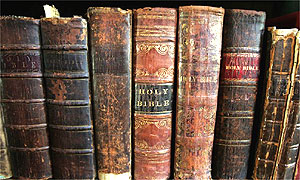- The Guardian
- Thursday September 6 2007

Copyright of the King James Bible, one of the first widely available English-language editions, is vested in the crown in perpetuity.
What does the King James Bible have in common with an Ordnance Survey map? Both are subject to crown copyright, an ancient institution whose function is increasingly open to question. Ownership of almost all information produced at taxpayers' expense is one of the main legal weapons government has to control - or block - the re-use of public sector information in the knowledge economy.
Knowledge economy
By contrast, the US government does not claim copyright in its works. We argue that the UK government should follow the US in making all raw taxpayer-funded data available to the knowledge economy - except where that data compromises personal privacy or national security.
Some of our supporters say that a short cut to this state of affairs would be to abolish crown copyright itself. The idea is worth examining. Abolition was last floated in 1998, as part of a series of examinations in to what the government should do with its publishing arm, Her Majesty's Stationery Office. A green paper, Crown Copyright in the Information Age (tinyurl.com/2a8ea2), proposed abolition as one of seven options for crown copyright.
In the public consultation that followed, abolition emerged as the most popular. From 70 responses received, abolition received 12 votes as preferred choice. The runner-up (retaining copyright but in a simpler form) received eight votes. The snag was that although abolition was the most popular response, it was also the least popular, receiving the largest number of "unacceptable" votes.
Faced with this polarised response, the government chose compromise. In 1999, the Cabinet Office found a "general consensus" in favour of retaining copyright, with simplified procedures for re-use. This is broadly the strategy of the body responsible for controlling copyright, the Office of Public Sector Information (part of the National Archives), whose head, Carol Tullo, also enjoys the title the Queen's Printer. Today, the office runs a "click-use" licensing scheme for crown copyright and other government material. This is a Whitehall version of "creative commons", allowing the free reproduction of material provided the source is acknowledged.
Officials at the office say that, far from stifling the re-use of public information, crown copyright can help it happen. "Copyright helps ensure greater consistency in our licensing approach," says Jim Wretham, head of information policy. "It also protects the overall integrity of information, its badge of authenticity."
Judging by recent investigations on the re-use of public-sector information carried out by the Office of Fair Trading and the Cabinet Office, a debate about the abolition of crown copyright would be as polarised today as it was in 1998.
Even if a consensus could be built, abolition would not by itself open access to much information. While the list of crown bodies runs to several hundred organisations, from the Prime Minister's Office to HM Prison Service, swathes of data are owned by non-crown bodies. Top of the list come local authorities, who own the rights to data created at public expense.
Subtleties of constitution
Other exceptions are non-departmental public bodies such as the Environment Agency, which earlier this year was at the centre of a row about how it charges for data on the location of water sources. The reason lies with the subtleties of the British constitution: the Environment Agency is not a crown body, because its watchdog functions require it to take legal action against crown bodies, and the Queen cannot sue herself. The Financial Services Authority and the British Standards Institute are likewise non-crown bodies.
And ancient constitutional oddities abound. One such is the Authorised (King James) Version of the Bible. In the 17th century, the English-language Bible was a weapon of war, and rights are "vested in the crown" in perpetuity.
The simplest way to abolish crown copyright might be to abolish the crown itself. That, however, would take our campaign into much trickier waters.
A history of rights
From the Domesday book on, British governments have recognised the power of asserting ownership of information. In 1604, King James 1 authorised a new standard English translation of the Bible; because of its historical value in promulgating Protestantism, rights remain owned by the Crown. In 1990, the House of Lords ruled that the government could assert Crown copyright to prevent publication of the MI5 memoir, Spycatcher. Today, Crown copyright lasts for 125 years, or 50 years from commercial publication.
The modern bureaucracy of Crown copyright dates from 1786, with the formation of a new Treasury department, His Majesty's Stationery Office (HMSO). In 1882, HMSO was made the official publisher to both Houses of Parliament, which still retain copyright on official proceedings. In 1889, Queen Victoria granted the controller of HMSO Royal Letters Patent as "printer to Her Majesty of all Acts of Parliament". The Letters Patent appointed the controller to hold Crown copyright. This grant and the office of the Queen's Printer continues today. In 1980, HMSO became a trading fund. In 2000, the government repositioned HMSO to regulate Crown copyright licensing. This role was taken on by the Office of Public Sector Information, now part of the National Archives.
· Join the debate at the Free Our Data blog: freeourdata.org.uk/blog
